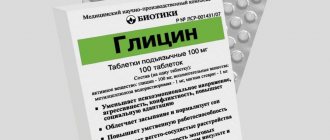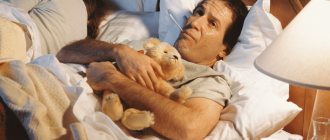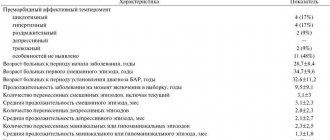Nowadays we hear the definition of “vegetative-vascular dystonia” everywhere.
Its owners are 80% of the population. Generally speaking, this condition occurs due to an imbalance in the functioning of the nervous system and includes about 150 symptoms. It requires an integrated approach to treatment, including medication. The drug Glycine for VSD has a fairly effective effect, since its main work is aimed at normalizing nervous processes. It is prescribed for almost every case of dystonia, but the intensity of the drug’s effects depends on the form of the condition and some other factors.
pharmachologic effect
The main substance of the drug is a non-essential amino acid. It is a mediator of nervous excitation. Thanks to its composition, Glycine has a sedative effect, improves metabolic processes in brain tissue, and increases the body's resistance to various damaging factors, including hypoxia.
Pharmacodynamics
Glycine is a regulator of metabolic processes. The drug increases brain activity and relieves the severity of symptoms of psycho-emotional stress. The drug normalizes sleep, improves mood, and alleviates the symptoms of menopause. Glycine is used as part of complex therapy to treat withdrawal symptoms. The drug reduces the severity of the consequences of traumatic brain injuries and cerebrovascular accidents.
Pharmacokinetics
Glycine penetrates into most biological fluids of the body. As a result of the metabolism of the drug, water and carbon dioxide are formed. Therefore, Glycine does not accumulate in tissues.
What is Glycine
Glycine was developed in Germany in 1820. The basis of the drug is a non-essential amino acid with the same name “glycine”. It is also called aminoacetic and aminoethanoic acid. It is formed in the human body, but under certain pathological processes its synthesis may be disrupted.
Glycine is a neurotransmitter in the central nervous system and forms the basis of certain proteins. It causes protective inhibition in the central nervous system, blocks the release of excitatory glutamic acid and stimulates the production of GABA, which is an inhibitory transmitter. By reducing the activity of motor neurons, glycine helps get rid of muscle hypertonicity.
In addition, the amino acid inhibits the activity of alpha-adrenergic receptors, exhibits antioxidant and antitoxic properties, and improves the metabolism of nerve cells. Thus, glycine during VSD suppresses excessive activity of the sympathetic nervous system, helps eliminate overexcitation and restore harmony between the two sections of the VNS.
In addition to aminoacetic acid, the drug contains additional components: methylcellulose and magnesium stearate.
Indications for use
The main indications for the use of Glycine include:
- prolonged psycho-emotional stress;
- decreased memory and attention;
- consequences of ischemic or hemorrhagic stroke;
- insomnia;
- neuroses;
- encephalopathy of any origin;
- treatment of withdrawal syndrome (hangover) due to alcohol intoxication;
- vegetative-vascular dystonia;
- relief of clinical symptoms during menopause;
- tension headache and dizziness;
- complex therapy of arterial hypertension.
The use of Glycine during breastfeeding is permitted under strict indications and under medical supervision.
The drug is used sublingually (under the tongue) or buccally (between the upper lip and gum). The dosage of the drug is 100 mg. Glycine is prescribed 1 tablet 2-3 times a day. Before using the drug, it is recommended to consult a doctor to determine the required dose, frequency of administration and course duration.
Analogs and derivatives
There are several derivatives of Glycine. In fact, they all have the same active ingredient; the differences lie in the dosage of the drug. So, 1 tablet of Glycine Fortes contains 250 mg of glycine, and Glycine-Canon – 1000 mg.
Considering that the state of the nervous system suffers with VSD, doctors recommend, in parallel with glycine, taking multivitamins based on B vitamins. They help restore the functioning of the central and peripheral nervous system, balance the processes of inhibition and excitation, and improve the passage of nerve impulses. They normalize the functioning of the muscular system, participate in the synthesis of amino acids, neurotransmitters and nucleic acids.
Of these drugs, the most famous are Pentovit and Neuromultivit.
| Comparative characteristics | |||
| A drug | Compound | Mode of application | Well |
| Pentovit | vitamin B1–10 mg; vitamin B6–5 mg; vitamin B12–0.05 mg; folic acid; nicotinamide; | 2–4 tablets 2–3 times/day after meals | 1 month |
| Neuromultivitis | vitamin B1–100 mg; vitamin B6–200 mg; vitamin B12–0.2 mg | 1 tablet 1 time/day | 1 month |
According to reviews, the combination of Glycine + Neuromultivit definitely gives a positive result. Users note that anxiety goes away, concentration increases and performance improves. It is possible to get rid of irritability and depression.
Multivitamins are contraindicated for children, pregnant women and lactation. For this treatment regimen, there is an alternative - the drug Glycine-Vis. This is a complex product that includes Glycine and vitamins B1, B6, B12.
Glycine analogues include phenotropil, tryptophan, piracetam, mexidol. They also belong to nootropic drugs, but their effect manifests itself a little differently, so they will not fully replace glycine.
Glycine is an effective remedy, but there are times when it cannot cope alone. Therefore, doctors prescribe other medications to complement it. For example, picamilon, spasmalgon, banal Corvalol and valerian.
Glycine overdose
Symptoms of a Glycine overdose occur when the drug is taken incorrectly, as well as when it is consumed simultaneously with alcoholic beverages. In order for signs of drug intoxication to appear, a single dose of 15-20 tablets of the drug is required. The main manifestations of overdose include:
- drowsiness;
- dizziness;
- loss of consciousness;
- vomit;
- nausea;
- stool instability;
- dry mouth;
- sopor;
- bronchospasm;
- anaphylactic shock.
First aid before the doctor arrives is to lavage the stomach. To do this, you need to drink 1.5 -2 liters of water and press on the root of the tongue. If the medicine was taken a long time ago, then in order to alleviate the condition, it is recommended to drink an absorbent drug. Severe forms of Glycine overdose require immediate hospitalization. In the hospital, the severity of the condition is determined and appropriate detoxification therapy is carried out.
Interaction
The effect of taking Glycine largely depends on what medications it interacts with. The combined use of Glycine with sedatives of herbal origin is permitted. This combination is used in the complex treatment of anxiety disorders and sleep disorders.
The interaction of Glycine with other nootropic drugs leads to an increased sedative effect. The combined use of these drugs is acceptable.
When Glycine is prescribed simultaneously with drugs from the tranquilizer group, the inhibition of the central nervous system is additive. This combination of drugs is acceptable in the treatment of neuroses, sleep disorders, and psycho-emotional disorders. Dosages are determined by the attending physician based on the disease and the severity of its condition.
The combined use of Glycine with neuroleptics, antidepressants and anticonvulsants reduces the severity of their side effects.
Complications of taking the drug
Glycine is a drug that is well tolerated by the body. This is due to the fact that the amino acid in its composition is a natural substance for humans. It is quickly absorbed by tissues and causes virtually no side effects. The latter appear in extreme cases and are expressed in the form of drowsiness, weakness and low blood pressure.
The product has virtually no contraindications. It can be taken by adults and children, pregnant women and women during breastfeeding. But it is worth considering that Glycine neutralizes the effect of neuroleptic drugs, sleeping pills, anticonvulsants, and antidepressants.
The only obstacle to treatment with the drug is its individual intolerance. In patients with hypotension it should be used under blood pressure control.
Glycine can be purchased at a pharmacy without a prescription.
Glycine analogs
In cases where the use of Glycine is impossible for some reason, it is recommended to replace it with drugs with similar effects. These include Afobazol, Tenoten, Noopept, Valerian, Mexidol, Picamilon, Ginkum, Piracetam, Novopassit, Divaza, Eltacin.
Which is better: Glycine or Afobazole?
Afobazole is an anxiolytic drug. The drug reduces the manifestations of anxiety syndrome and normalizes sleep. The active ingredient Afobazole is morpholinoethylthioethoxybenzimidazole dihydrochloride. Despite the fact that the drug was specially developed to reduce the excitability of the nervous system, it does not have a hypersedative effect. Taking Afobazole does not cause drowsiness or reduce concentration. Indications for taking Afobazole include:
- sleep disorders;
- increased anxiety;
- irritability;
- various diseases, including systemic lupus erythematosus, cerebrovascular disease, dementia of various origins, irritable bowel syndrome and other somatic pathologies;
- premenstrual syndrome;
- the need to remove alcohol and nicotine from the body.
Afobazole and Glycine have a similar mechanism of action. Both drugs are available in tablet form. Afobazole is taken with a sufficient amount of water, and Glycine is placed under the tongue. The differences between drugs lie in the active ingredients. Afobazole is a chemical, Glycine is an amino acid natural to the brain. Therefore, taking Glycine is allowed during pregnancy, unlike Afobazole. To enhance the effect of treating anxiety disorders, co-prescription of medications is indicated.
Which is better: Glycine or Tenoten?
Tenoten is a nootropic drug. It has antiamnestic, antidepressant, antiasthenic, antihypoxic and neuroprotective effects. The active substance of Tenoten is affinity purified antibodies to the brain-specific protein S-100. The main indications for the use of the drug include:
- stress;
- neuroses and neurosis-like conditions;
- memory impairment;
- emotional lability;
- encephalopathy;
- organic diseases of the central nervous system.
Glycine and Tenoten belong to the group of nootropic and anxiolytic drugs. Their action is aimed at activating brain activity. The drugs are available in the form of tablets that are taken sublingually. Tenoten is indicated for increased psycho-emotional tension. To improve memory and attention, it is better to choose Glycine. This drug is also suitable for use during pregnancy. Taking medications together is indicated when prescribing complex therapy.
Which is better: Glycine or Noopept?
Another representative of the group of nootropic drugs is Noopept. The drug has a neuroprotective, antioxidant and vegetative-normalizing effect. The active substance of the drug is N-phenylacetyl-L-prolylglycine ethyl ester. Increases the resistance of brain tissue to various damages. With the development of ischemic stroke, Noopept is prescribed to reduce the volume of the lesion. The drug improves the rheological properties of blood, restores memory and cognitive functions of the brain. Indications for prescribing Noopept are:
- memory and attention disorder;
- cerebrovascular accident;
- encephalopathy;
- recovery period after being in a coma;
- consequences of traumatic brain injury.
Glycine and Noopept help improve brain activity and restore memory. Both drugs are available in tablet form. Glycine is used sublingually. Noopept tablets are taken orally with enough water.
Which is better: Glycine or Valerian?
Valerian is a sedative of plant origin. Has a sedative and antispasmodic effect. The active ingredients of the drug are isovaleric acid and borneol ester. Thanks to its properties, the drug helps normalize sleep and stool, reduces the severity of spasms, and improves cardiac activity. Taking Valerian reduces the risk of migraines and epileptic seizures.
The main indications for taking Valerian include:
- sleep disturbance;
- tachycardia of any origin;
- emotional lability;
- neurodermatitis;
- migraine-type headache;
- complex therapy of arterial hypertension;
- menopause;
- increased gas formation;
- constipation;
- epilepsy attacks.
Valerian has restrictions on its use. These include the first trimester of pregnancy, individual intolerance to the components of the drug, depression and low blood pressure. Valerian and Glycine normalize sleep and reduce the severity of anxiety. One of the differences between the drugs is their composition. The active component of Glycine is an amino acid, Valerian is a completely herbal preparation. Taking Valerian can be accompanied by a large number of side effects. Before using medications, it is recommended to consult a doctor. The specialist will conduct the necessary diagnostics and, based on the results obtained, choose a medicine.
Which is better: Glycine or Mexidol?
Mexidol is an antioxidant drug. The active substance of the drug is ethylmethylhydroxypyridine succinate. Mexidol increases the body's resistance to various damaging factors, helps normalize blood microcirculation in the brain, and reduces the severity of alcohol intoxication. The drug improves the rheological properties of blood, stabilizes the processes of wakefulness and sleep. Indications for prescribing Mexidol are:
- consequences of traumatic brain injury;
- neuroses and neurosis-like conditions;
- withdrawal syndrome;
- vegetative dystonia;
- cardiac ischemia;
- cerebrovascular pathology;
- cognitive impairment;
- consequences of acute cerebrovascular accidents.
Glycine and Mexidol have a sedative and nootropic effect. Helps normalize brain activity, restore sleep and reduce the severity of anxiety. The differences between the drugs are in the form of release, active substances and additional properties. Glycine is produced in the form of tablets for oral administration. Mexidol is available in the form of tablets, injection solution and toothpaste. Glycine contains an amino acid that is natural to the brain. The active substance of Mexidol is ethylmethylhydroxypyridine succinate.
Which is better: Glycine or Picamilon?
Picamilon is a drug from the nootropic group. It has an antioxidant, vasodilator and sedative effect. The active substance of the drug is nicotinoyl gamma-aminobutyric acid. Picamilon improves the processes of memory, thinking and attention. Thanks to its sedative effect, the medicine helps reduce the severity of anxiety and normalize sleep. Indications for the use of Picamilon are:
- diseases of the brain of vascular, inflammatory or traumatic origin;
- depression;
- consequences of alcohol abuse;
- migraine-type headache;
- excessive mental and physical stress;
- prolonged stress;
- conditions accompanied by nervous exhaustion;
- open angle glaucoma.
Unlike Glycine, Picamilon has a more pronounced effect. However, its side effects appear much more often and to a greater extent. Glycine has a gradual effect, noticeable after a course of administration. The combined use of drugs is allowed. They complement each other's action. This combination of drugs is actively used by doctors for adolescents during periods of mental overload.
Which is better: Glycine or Ginkoum?
Ginkoum is a sedative of plant origin. The active substance of the drug is ginkgo biloba extract. The action of Ginkoum is associated with improved blood microcirculation in the brain and a positive effect on memory. A course of taking the drug has an antioxidant effect, reducing the risk of developing cancer. The main indications for the use of the drug are:
- cerebrovascular accident;
- dizziness;
- noise in ears;
- cerebrovascular diseases;
- weakness, increased fatigue;
- migraine-type headache;
- high blood pressure;
- encephalopathy of various origins;
- a condition caused by brain hypoxia.
Glycine and Ginkoum are nootropic drugs of plant origin. The range of their actions and indications is largely similar. Glycine is available in tablet form. Ginkoum is produced in the form of capsules for oral administration. The drugs are well tolerated. Before use, it is recommended to consult a doctor to determine the dosage, frequency of administration and course duration.
Which is better: Glycine or Piracetam?
Piracetam is a nootropic drug. It is a cyclic derivative of gamma-aminobutyric acid. The active ingredient of the drug is piracetam. Thanks to its properties, the drug increases the body’s resistance to various toxic substances, minimizes the risk of developing seizures, helps improve the functional activity of the brain, and activates its metabolic processes. The main indications for the use of Piracetam include:
- memory impairments of various origins;
- dementia;
- cortical myoclonus;
- cerebrovascular accidents;
- complex therapy of alcohol intoxication;
- chronic fatigue;
- coma;
- neurasthenia.
Both drugs have a nootropic effect. Glycine is produced in the form of tablets for oral administration. Piracetam is produced in the form of tablets and solution for injection.
Which is better: Glycine or Novopassit?
Novopassit is one of the sedative medicines based on herbal components. The drug has no anti-anxiety and sedative effect. Novopassit helps reduce the severity of anxiety, normalizes sleep, and eliminates tension headaches. Due to its properties, the drug is used to relieve premenstrual syndrome and menopausal symptoms. Novopassit is prescribed for the following conditions:
- migraine;
- conditions accompanied by constant nervous tension;
- neuroses and neurosis-like conditions;
- tension headache;
- sleep disturbance;
- menopause;
- psychogenic itching;
- irritable bowel syndrome.
Both drugs affect the central nervous system. They have a minimal number of contraindications. Novopassit is available in the form of tablets and solution for oral administration. Glycine is produced in the form of tablets for sublingual use. Novopassit contains plant components in combination with semi-synthetic guaifenesin. Glycine is an amino acid that is naturally found in the brain.
Which is better: Glycine or Divaza?
A representative of the group of nootropic drugs is Divaza. The drug has neuroprotective, anxiolytic, antidepressant, antioxidant, neurometabolic and sedative effects. Divaza helps to increase the brain's resistance to the effects of toxic substances, as well as to hypoxia. The medication improves cerebral circulation, memory, thinking and attention. The active ingredients of the drug are antibodies to the brain-specific protein S-100 and antibodies to endothelial NO synthase. Indications for the use of Divaza include:
- ischemic stroke;
- memory and attention disorder;
- emotional lability;
- consequences of traumatic brain injury;
- symptoms of vegetative-vascular dystonia;
- neuroinfections;
- long-term stress loads.
Divaza and Glycine are used to improve brain activity, stabilize the emotional background, and restore cognitive functions of the brain. The differences between the drugs lie in the mechanisms of action and active substances. Divaza contains antibodies to the brain-specific protein S-100 and antibodies to endothelial NO synthase. Glycine is a naturally occurring amino acid in the brain. Divaza promotes the regeneration of brain cells, increases the speed of transmission of nerve impulses and improves memory. Glycine reduces the excitability of brain cells, normalizes sleep and restores memory. Taking Divaza is contraindicated for persons under 18 years of age. Glycine is approved for use from school age.
Which is better: Glycine or Eltacin?
Eltacin is an antioxidant combination drug. The drug contains glycine, L-glutamic acid and L-cysteine. Eltacin helps normalize metabolic processes in the body, increases its resistance to negative factors and hypoxia, increases endurance and shortens the recovery period after intense physical activity. Indications for prescribing the drug are:
- autonomic dysfunction;
- chronic overexertion;
- alcohol intoxication;
- chronic heart failure;
- recovery after prolonged physical activity.
Glycine and Eltacin have a similar composition, mechanism of action and effects. Thanks to the enhanced composition, Eltacin has more pronounced properties. Concomitant use of drugs is prohibited. This is due to the possibility of glycine overdose. The dosage, frequency of administration and duration of the course should be determined by the doctor.
The essence of the process
It turns out that the list of the International Classification of Diseases does not include such a disease as vegetative-vascular dystonia. Therefore, it is classified as a symptom complex that can accompany many ailments.
VSD develops due to improper functioning of the autonomic nervous system, which regulates the functioning of internal organs, glands and blood vessels. When it fails, the activities of the listed structures are disrupted. Therefore, VSD is accompanied by such a wide range of symptoms:
- pain of varying localization and intensity. It is permanent;
- pain in the heart, palpitations;
- prostration;
- breathing disorder;
- cold extremities;
- sleep disturbance;
- dizziness and fainting;
- hand tremors;
- decrease or increase in pressure;
- digestive disorders;
- excessive sweating;
- bad mood, irritability, apathy and other mental disorders.
The autonomic nervous system consists of 2 divisions: sympathetic and parasympathetic. By their nature they are antagonists, that is, they perform opposite actions. If the sympathetic system increases the heartbeat, inhibits peristalsis and salivation, reduces the tone of the bladder, dilates the pupil and bronchi, then the parasympathetic system has the exact opposite effect. The parasympathetic division of the NS is activated when we are at rest. The sympathetic nervous system is activated during stressful situations.
Ideally, they should work harmoniously, complementing each other. Then our health is normal. If one of the systems begins to dominate over the other, a malfunction occurs in the body, such as VSD.
There is a theory that this condition is of a congenital, genetic nature. At the same time, a number of changes occur in the ANS, such as excessive or insufficient activity of coordinating centers, disruption of receptor sensitivity and some metabolic processes.
Vegetative-vascular dystonia comes in several types:
- cardiac;
- vascular;
- gastrointestinal;
- respiratory;
- genitourinary;
- musculoskeletal;
- neuropsychic;
- thermoregulating.
All of them are characterized by different symptoms and have their own causes.
Glycine during pregnancy and lactation
There are still no studies confirming the absolute safety of the drug for pregnant women. Therefore, its use during pregnancy is strictly indicated when indicated and under the supervision of a doctor. The dosage of the drug is selected individually based on the characteristics of the woman’s body.
The use of Glycine during lactation is permitted. The drug has a mild effect on the body. A small amount of the medicine passes into breast milk. The permitted dosage is selected individually for each woman.
A cure for everything or a dummy?
Doctors are still arguing whether glycine is beneficial. We tried to figure it out
Arguments for
Glycine plays an important role in our body. It is part of many proteins and biologically active compounds and is involved in important reactions. In addition, glycine receptors are present in many areas of the brain and spinal cord.
Hundreds of studies show that glycine can improve human conditions:
- when tired,
- negative consequences of stress,
- alcoholism,
- sleep disorders,
- consequences of stroke and head injuries,
- excessive excitability,
as well as in many other situations, including schizophrenia.
This substance is non-toxic. It is already produced in our body and is easily absorbed. At least, no harm has yet been identified from taking the drug in recommended doses.
Arguments against
It is not entirely clear how easily glycine crosses the blood-brain barrier, a special mechanism that allows foreign substances to enter the brain through blood vessels. Perhaps the main part of the tablet is distributed through the stomach to different organs, and only small remnants or nothing at all reach the main recipient - the brain.
Supporters of strict evidence-based medicine claim that there is not yet enough experimental data confirming the benefits of glycine. Need more statistics.
Yes, glycine seems to be safe (but this is not certain). After eating pork jellied meat, we receive a dose of this substance equivalent to thousands of tablets. It seems like nothing bad is happening to us. The therapeutic effect, however, is also somehow not obvious.
Conclusion
If glycine helps you, take it! Even if the healing effect has not yet been proven, no one cancels the effect of placebo. In addition, the “healing pacifier” effect works well in cases where glycine is prescribed - for example, during stress or reduced concentration.








